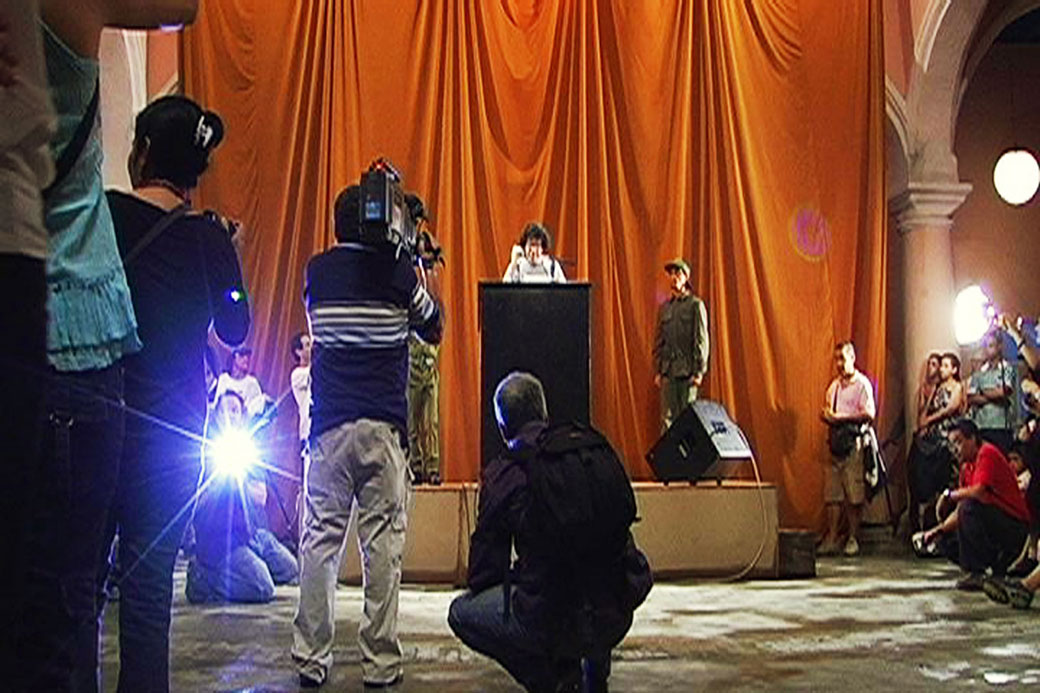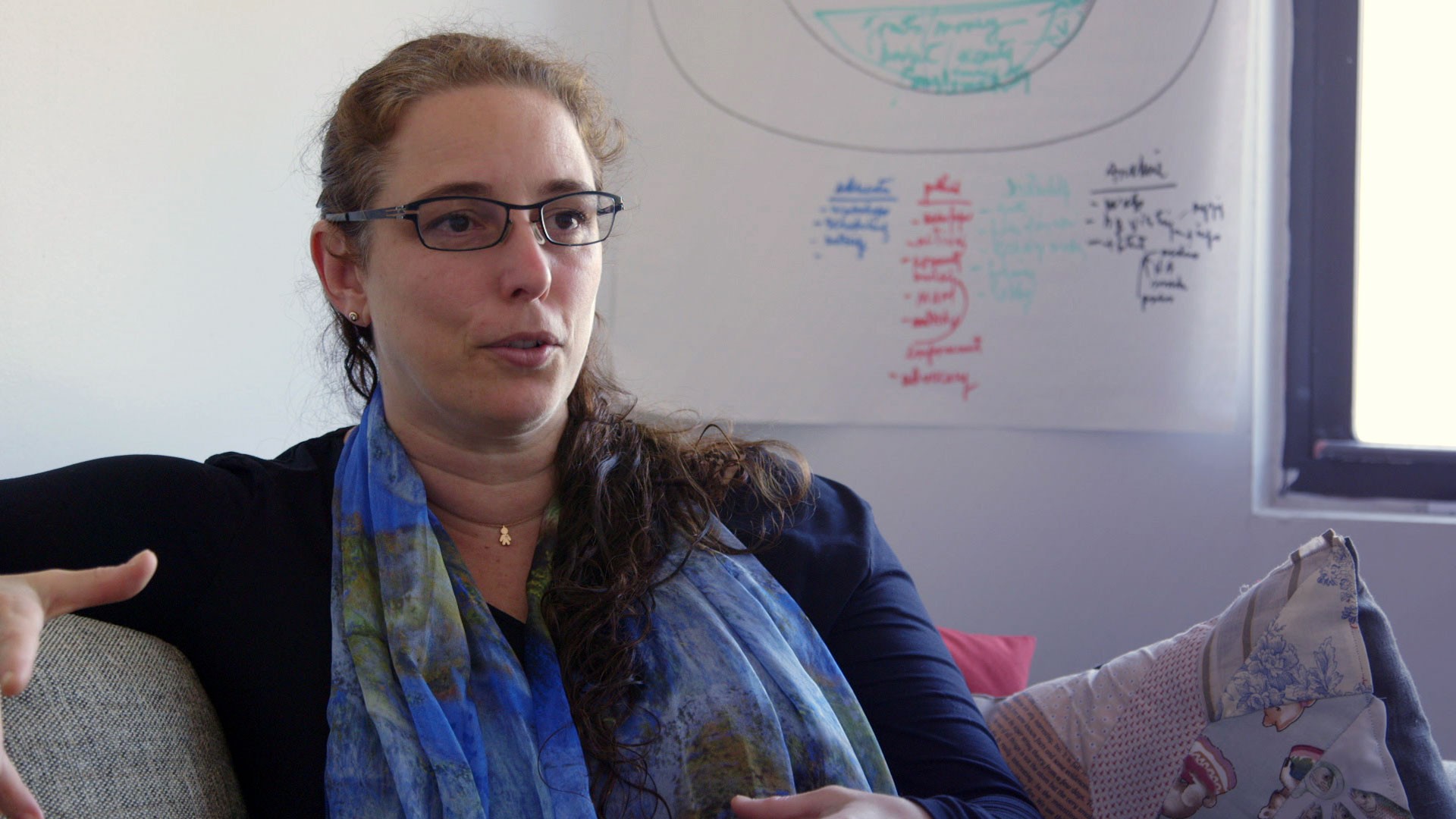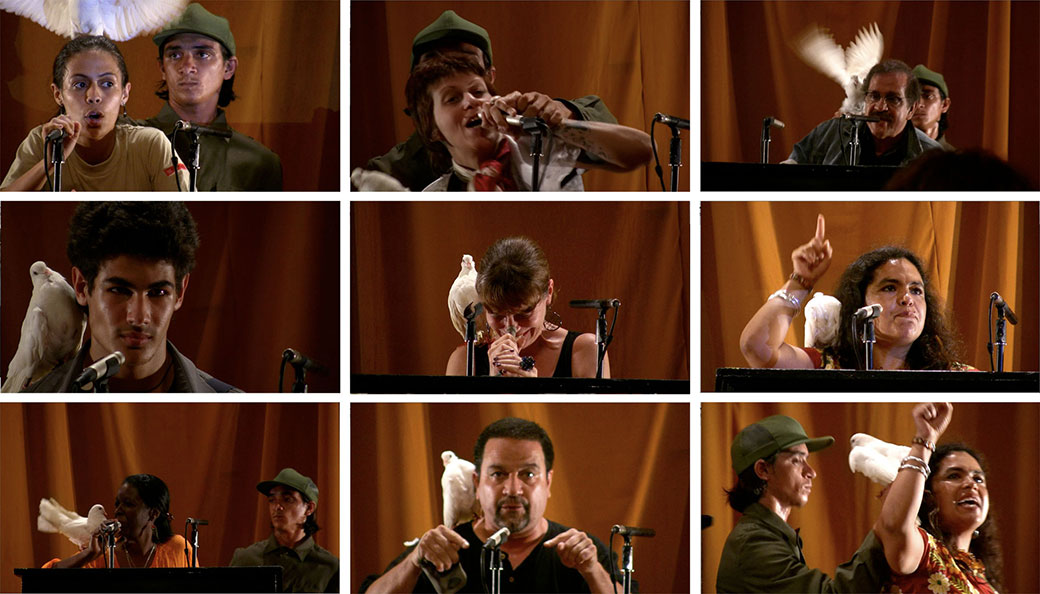
Tania Bruguera. El susurro de Tatlin #6 (Versión La Habana) / Tatlin’s Whisper #6 (Havana version), 2009. Decontextualization of an action: stage, podium, microphones, one loudspeaker inside and one loudspeaker outside of the building, two persons dressed in military outfits, white dove, one minute free of censorship per speaker, 200 disposable cameras with flash; dimensions variable. Performance view: Tenth Havana Biennial, Central Patio of the Wifredo Lam Contemporary Art Center, Havana, Cuba. Video documentation of performance: HD video; 40 minutes 30 seconds; edition of 5 (+ 1 AP). Courtesy Studio Bruguera. © Tania Bruguera
Some revolutionaries prefer silence. They seek out the soft shadows of their innovations. They provoke from behind the scenes, where they are perhaps freer to let their ambitions soar. Such was the case with Susan Sollins, the founder of ART21, my mentor of fifteen years, and a friend to countless artists around the world. Her passing is an occasion to ponder what revolution means, how it’s achieved, and whom it’s for.
The debut season of ART21’s series Art in the Twenty-First Century on PBS reached millions of Americans who were trying to make sense of the traumatic events of 9/11. At the time, I was an MFA student at Yale, leading sculpture critiques with despondent undergraduates while asking myself, “What is the role of art in times like these?”
In a major center of the art world, I couldn’t have felt more isolated. So I locked the door to my studio—for months—and told others I was only interested in making dust. As xenophobia spread on the news, as plutocrats and politicians alike used the state of crisis to cover their ambitions, there was Susan and the television series to gently remind me what truly mattered. A beacon amid the tumult, ART21 was a program advocating for the importance of reflection and introspection, for engaging with the unfamiliar, and for valuing ideas above what could be pumped out of the ground. Susan believed the practice and appreciation of contemporary art was revolutionary and found ways—through filmmaking—to make it personal, memorable, and accessible.
While she idolized artists with distinctive voices and found inspiration in compelling stories—crediting Vasari’s Lives of the Artists as a milestone worth emulating—Susan taught me a remarkable thing: the delicate and often maligned art of ghost writing. She drew out the best in others. She spoke through artists, distilling their points of view to a degree of clarity that, like the best of spirits, has both bite and warmth. She only begrudgingly considered herself an author or artist in her own right. This is reflected in the spare and neutral style of her films. A viewer did not notice her, nor her style, but rather the artists and the art itself. And yet, her guiding hand can be felt throughout each film, most noticeable for what it deliberately pushed aside: distraction. It’s easy now to take for granted how radical this approach was. Before ART21, documentary films about artists were often anchored by opinionated hosts; whether acerbic or jovial, they were always (they must be!) entertaining. Artists were presented as romanticized heroes and tragic anti-heroes, like ships adrift on a sea of grand symbolic narratives, yet their destinies were assured. Allergic to a stance of imposition, Susan’s revolutionary gesture was and remains refreshing: to listen and absorb.

Tania Bruguera. Production still from the ART21 Art in the Twenty-First Century Season 7 episode Legacy, 2014. © ART21, Inc. 2014
Susan’s final interview was with artist and activist Tania Bruguera at the Queens Museum of Art on March 24, 2014. I produced the shoot and, as with so many interviews before, stood off to Susan’s side and eavesdropped intently on the conversation. The urgent subject at hand was how to convey the conception, creation, and problems inherent to socially engaged art.
Preferring pragmatism over theory, Susan chose to reach the topic indirectly by asking the artist about her childhood. Bruguera revealed how she was the daughter of a Cuban diplomat and a firsthand witness to the ways in which her home country’s revolution was broadcast to the world. Returning to live in Cuba as a teenager, she recalls, “I started seeing the distance between the promises and the accomplishments.” From this difficult memory, Bruguera goes on to crystallize what motivates her as an artist:
I still believe in a dream. And as an artist I feel that everything I’ve been trying to do is trying to kind of force or redirect reality towards the dream, but with the knowledge that propaganda is different than reality. And trying to, in a way, push people to be realistic about the goal and about the political means, instead of presenting us with just a dream.
“Part of the homework that socially engaged art has to do is rethink the way in which the project survives beyond the artist,” Tania told Susan, going on to explain:
I see really good socially engaged art and political art live beyond the life that the artist has given it, by being taken by other people who are reproducing the models, changing those models, and being inspired by that. The art that we should be doing today, in the twenty-first century, is art that is not for the museum. It’s art for the street and people’s lives.
As a ghostwriter, one tries on the words and ideas of others—like clothes—to see how they fit. I can’t help but wonder if Susan’s decision to include the above statements in her final film—appropriately titled Legacy—wasn’t also a way to consider her own desires and accomplishments.

Tania Bruguera. El susurro de Tatlin #6 (Versión La Habana) / Tatlin’s Whisper # 6 (Havana version), 2009. Decontextualization of an action: stage, podium, microphones, one loudspeaker inside and one loudspeaker outside of the building, two persons dressed in military outfits, white dove, one minute free of censorship per speaker, 200 disposable cameras with flash; dimensions variable. Performance view: Tenth Havana Biennial, Central Patio of the Wifredo Lam Contemporary Art Center, Havana, Cuba. Video documentation of performance: HD video; 40 minutes 30 seconds; edition of 5 (+ 1 AP). Courtesy Studio Bruguera. © Tania Bruguera
Revolutions are like heirlooms. Passed from one generation to another, they accrue a subtler value. Their worth grows not in the rising price of metals or the rarity of their designs but in the act of transfer, of their being handed down. In her lifetime, Susan was able to see this transformation, as people who encountered early seasons of ART21 in turn began to share and teach with the documentaries, inspiring a younger generation. Working in the studio became a little less lonely, too; Susan delighted in hearing stories of artists who, opening their laptops, would play ART21 in the background, like the radio. Folding time and space, Susan created the world’s largest studio building—albeit virtual—where the most innovative artists are working just down the hall. An entire day’s worth of her documentaries, each film compressing a lifetime of learning and discovery, can fit on a drive in the palm of your hand.
This is a kind of revolution worth inheriting.



